In an electric vehicle (EV) the lithium-ion battery represents 30 – 40% of the cost. In the battery the battery cells represent 60 – 70% of the cost. Consequently, about 15 – 30% of the cost of an EV are the battery cells.
As important as the cost of the battery cells are the performance characteristics: energy density that translates into range, charging time, safety, life, etc. Altogether, it makes the choice of battery cells crucial for success or failure of an EV.
No company has understood this better than Tesla. They early teamed up with Panasonic, a relation which remains strong today. It is Panasonic, who built, owns and operates the battery cell manufacturing inside Tesla’s first gigafactory. Panasonic started with the 18650 wound cells. Later they changed to the larger 2170 cells. To support Tesla’s growth Panasonic is building a new gigafactory in De Soto, KS, with a planned capacity of 30 GWh and production starting in March this year (2025). Tesla and Panasonic have also worked together developing the 4680 cells. When Tesla in 2019 built its gigafactory in Shanghai they started sourcing battery cells from the leading Chinese companies, CATL and BYD. It reduced costs and increased the margins on the Tesla EVs built there
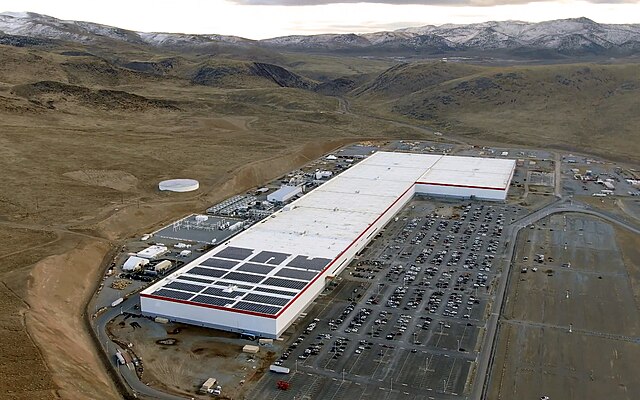
Creative Commons Attribution. Share Alike 4.0
The relations between Tesla and CATL and BYD, respectively have strengthened. Now, CATL is the main provider to Tesla’s bulk energy storage system (BESS) business, both in China and in the US. In Shanghai Tesla is building a dedicated factory for the Megapacks, the building block of utility scale BESS, with CATL building a dedicated battery cell factory there as well. In the U.S. Tesla and CATL takes the same approach, with dedicated factories, but with the difference that Tesla will own and operate the battery cell factory using the manufacturing equipment from CATL, who will assist in setting up and commissioning the production lines. The details of the agreement between Tesla and CATL have not been disclosed. Last year (2024) Elon Musk announced that Tesla will use BYD second generation blade battery for the Model Y cars built in its Berlin, Germany, gigafactory.

Creative Commons BY4.0 Attribution 4.0 International.
Almost all lithium-ion battery cells in the world are manufactured by Asian companies. According to Statista, for the first half of 2024 CATL had 37.8% market share of EV battery cells, followed by BYD at 15.8% and LG Energy Solutions (South Korea) at 12.9%. Together, these three companies cover two-thirds of the market. CATL and BYD combined over 50% market share. Of the Top Ten companies six are Chinese, three South Korean (LG Energy Solutions, SK On and Samsung SDI) and one is Japanese (Panasonic). Another company of interest is AESC, which was founded as a venture between Nissan and NEC (AESC was founded in 2007 by Nissan and NEC. Since 2019 Envision of China has become the majority owner.
The distinct leadership position of CATL and BYD is thanks to their early (some 15-20 years ago) bets on lithium iron phosphate (LFP) as the cathode chemistry and decades of continuous improvements, economy of scale (China is by far the biggest EV market) and a fierce competitive domestic market. The early investment in LFP was not assured. The nickel-based chemistries NCM (nickel cobalt manganese) and NCA (nickel cobalt aluminum), were preferred by Tesla and the other EV makers thanks to its higher energy density, which translates to better range. Going forward, thanks to remarkable improvements, all indications are that battery cells with LFP cathodes will be the dominant battery cell technology for lithium-ion batteries with CATL and BYD in the lead, but, no doubt, the other companies will follow.
However, the Chinese growing dominance in EVs and lithium-ion batteries have triggered geopolitical concerns both in the U.S. and in Europe. The concerns turned into explicit actions last year (2024). The import tariffs for EVs from China have been raised to 100% in the US and to 35% in addition to the existing 10% duty in Europe. For batteries and battery cells the tariffs have been raised to 25% both in the U.S. and Europe. It went into effect in 2024 for vehicle applications. For stationary battery storage applications in the US, it is scheduled to be implemented in 2026.
The response by the Asian companies has been to build battery cell factories in the US and in Europe. In the US, the Government has encouraged this development, which accelerated through the Inflation Reaction Act (IRA). However, Chinese companies are excluded from the IRA generous support. Still, Chinese companies like EVE Energy and Gotion HiTec are building manufacturing capacity in the U.S. Almost two-thirds of the new battery cell capacity is being built South Korean companies like LG Energy Solutions, which since 2012 has a factory in Holland, MI. It is being expanded to 25 GWh this year (2025). LG Energy Solutions also formed a joint venture, Ultium Cells LLC, with General Motors (GM). CATL, concerned about further restrictions, has refrained from building its own factories in the US. Instead CATL has chosen a route of partnerships and licensing programs. With Tesla it is already in place, but when Ford and GM try to take the same approach, lawmakers have raised concerns. Complicating matters further was the “blacklisting” of Department of Defense (DOD) in January this year (2025) designating CATL as a “Chinese Military Company”, something CATL has strongly objected.
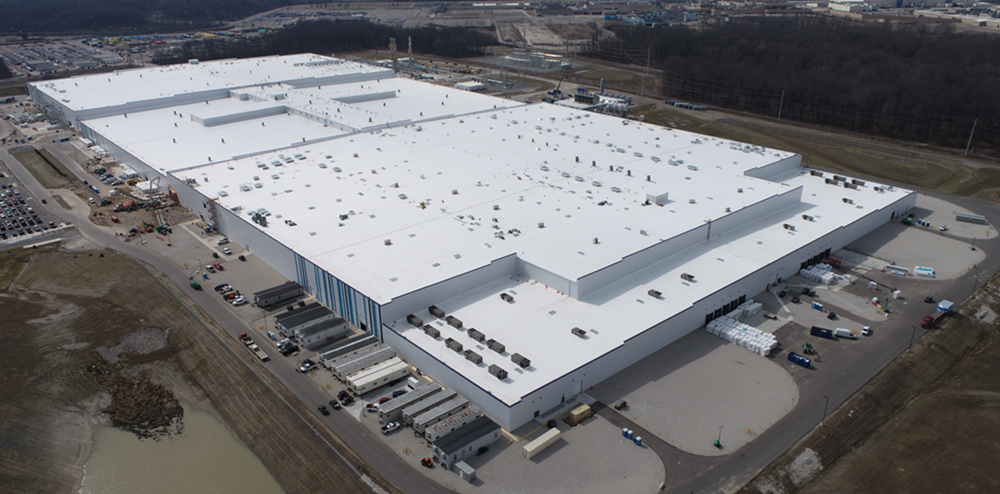
Picture from Ultium Cell’s website.
Europe has taken a more measured approach, open for Asian companies, including the Chinese, to set up factories in Europe. Nevertheless, concerned about the Chinese growing strength in EVs and batteries, the European Commission announced in 2017 the creation of the European Battery Alliance aiming for a “strong independent European battery industry” with support from the European Investment Bank (EIB). Northvolt became the flagship company for this wish/effort. Trying to do this from scratch and without any previous knowledge or unique technology turned out to be overwhelming. Northvolt filed for Chapter 11 in November 2024 after producing less than 1% of Northvolt 1 (Sweden) factory’s 16 GWh capacity and spending around $6 billion. At that time, the company had only $30M in cash, but $5.8 B in debt. Northvolt’s failure seems to have accelerated the efforts of CATL and BYD, and other Chinese companies to strengthen their presence in Europe. CATL has already factories in Germany and Hungary. In December last year (2024) CATL and Stellantis announced a joint venture to set up a battery cell factory in Spain with production to start by the end of 2026 with a capacity up to 50 GWh. Also, the South Korean companies are expanding existing factories or building new ones. In fact, LG Energy Solutions was the first battery company to set up a factory in Europe already 2016. This factory, located in Wroclaw, Poland, is now by far the largest battery cell factory in Europe with a capacity of 86 GWh.
Building regional supply chains in North America and Europe will take time, but it should eventually reduce geopolitical concerns. The transition from nickel-based battery cells, including NCA and NCM, to LFP-based battery cells should also more effectively enhance the development of regional supply chains. After all, iron and phosphate are much easier to find locally than it is to source nickel, cobalt, and manganese!
Tariffs on EVs may delay the growth of Chinese EVs in North America and Europe, but for North American and European EV car companies to have a fighting chance to be competitive they have no choice but, in addition to the South Korean and Japanese companies, to also source battery cells from the Chinese battery companies either directly or through partnerships or through licensing.
In most parts of the world, it takes time, a lot of it, to get the necessary permits to build a new transmission line. While few dispute the benefits of and need for more electric transmission, many oppose the lines to be built. The reasons can be several, but in most cases, it comes down to NIMBY (Not-In-My-Backyard).
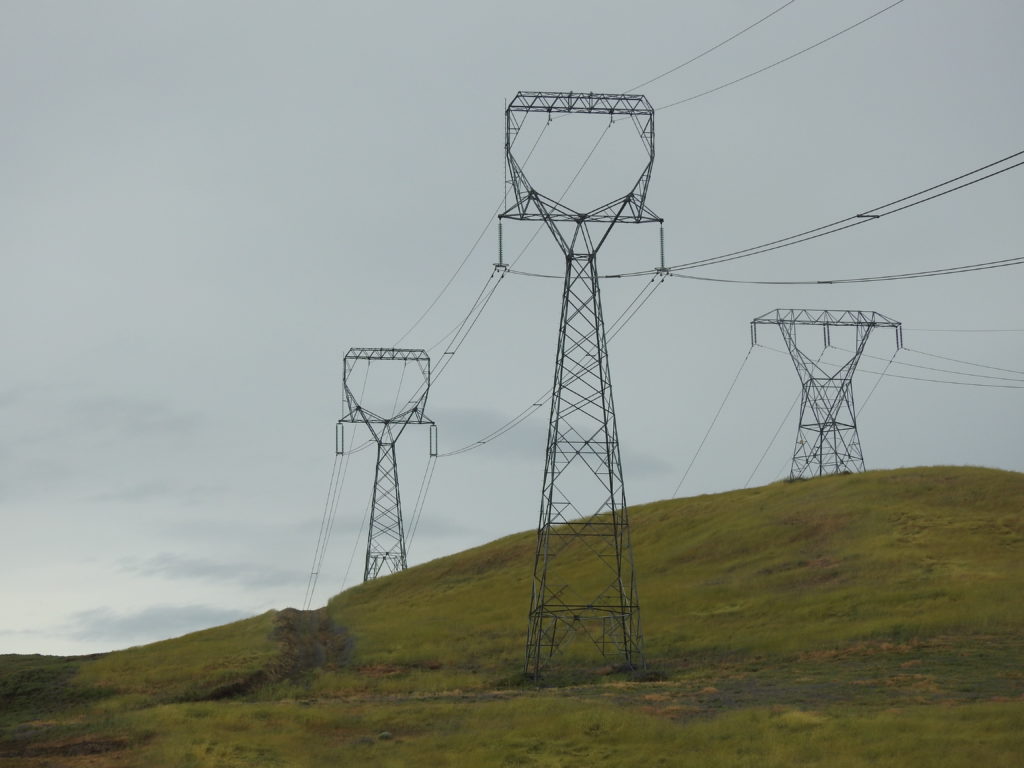
Pacific Intertie, a breakthrough transmission system at its time, initially, 1969, with a capacity of 2500 MW. With subsequent expansions the 400 kV HVDC line and the two 500 kW HVAC lines can bring 7900 MW of predominantly hydro power from the Pacific Northwest to the Los Angeles area. Photo by the author.
The common denominator for transmission projects moving ahead is thorough planning and persistence in working with public opinion and permitting authorities. For individual projects creativity and unconventional approaches can be effective enabling the project to happen. Below are some ongoing projects worth watching and learning from.
CONTINUE READING >>
The unprovoked Russian war against Ukraine has resulted in an electric energy crisis in Europe, in particular in Germany. Because of the escalation between sanctions and gas deliveries, Russia on September 2 for an indefinite time shut down Nord Stream 1, the main pipeline for the natural gas deliveries to Germany. It triggered higher electricity prices not only in Germany but all the surrounding countries. The indefinite time was further extended on September 26 after both Nord Stream 1 and Nord Stream 2 pipelines ruptured after a series of explosions. Added to the serious concerns about exceedingly high electricity prices are now concerns in Germany for the coming winter about grid reliability, as well as for the ability to adequately heat buildings.
However, there is more to the story about the crisis than losing the Russian gas through the Nord Stream pipelines. Germany has been fortunate to be able to import substantial amounts of electricity when short on own generation, but this summer the availability of power to import has been reduced. France, normally the biggest exporter of power in Europe, has had more than half of their nuclear reactors offline due to routine maintenance or to evaluate the risks of corrosion problems. In addition, the record drought in Europe dropped the water levels in many large rivers, not least in France. It reduced the hydro generation as well as put restrictions on the output from some of the nuclear reactors in operation. (The latter is due to limitations of the amount of available/allowed cooling water.)
CONTINUE READING >>
On February 24 Russia started an unprovoked full-scale invasion of Ukraine. It has resulted in colossal damage and sufferings. How the war will end nobody knows, but it seems clear that Ukraine will remain a free, independent, and democratic nation, while Russia will achieve truly little, if anything of its goals.
The war in Ukraine will also have unintended and significant energy and environmental consequences in all Europe. For some countries there will be changes in the direction of their respective energy structures and plans. In other cases, the direction will remain unchanged, but the speed of change will accelerate.
The most immediate change happened when Ukraine synchronized its electric grid with the ENTSO-E grid (European Network of Transmission System Operators for Electricity) on March 16. By all means and measures it was a huge engineering accomplishment. The first discussion had started in 2017. The target for completion was originally set for 2026, later adjusted to early 2023.
Cutting the electric ties with Russia so quickly was enabled by Ukraine having adequate domestic power generation. For the three Baltic States, Estonia, Latvia, and Lithuania it will be more challenging to desynchronize from the Belarus-Russia grid, since they are net importers of power. The solution here will be to building more transmission ties with Sweden, Finland, and Poland. The technology of choice and necessity is HVDC. There are already HVDC connections between Finland and Estonia, Estlink 1 and 2 with the combined capacity 0f 1000 MW. The NordBalt 700 MW HVDC link between Sweden and Lithuania has been in operation since 2015. When Harmony Link, the 700 MW HVDC link between Lithuania and Poland will be completed in 2025, it will be possible to cut all electric ties with Belarus and Russia.
The importance of strong ties with neighboring countries and the significance of HVDC for bilateral connections with submarine cables was very recently well illustrated when Russia announced suspension of electricity sales to Finland, which can be as much as 1300MW. Thanks to the strong AC and DC ties with Sweden, including the 1300 MW Fenno-Skan HVDC links, Finland easily offset the electric imports from Russia.
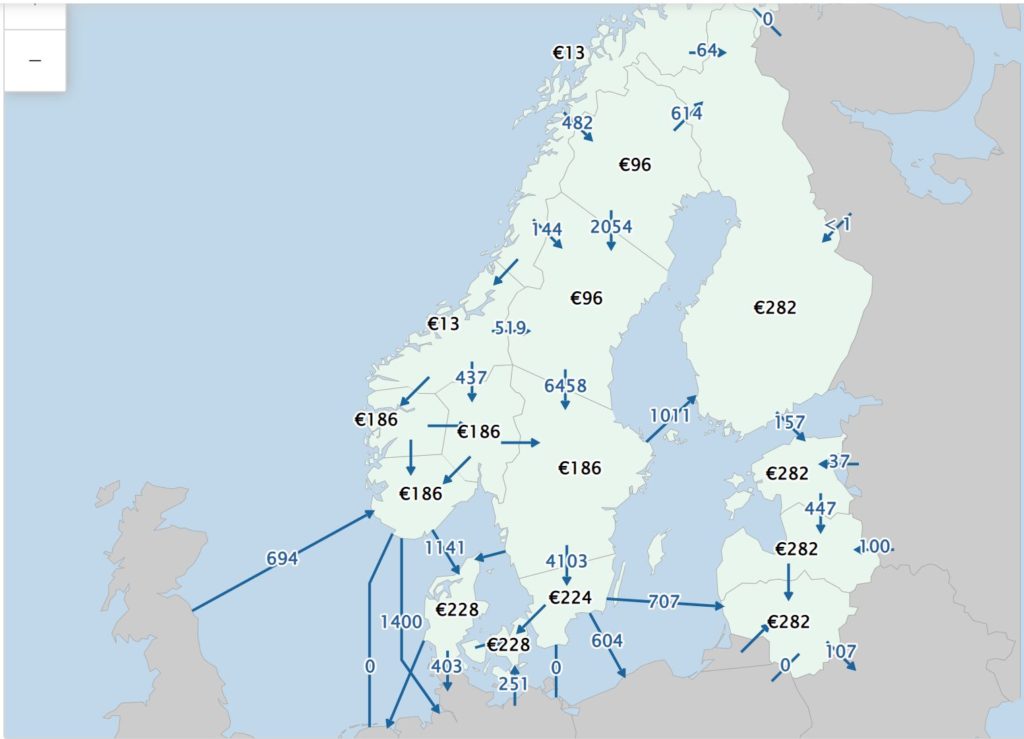
For the electric power generation, the consequences of the Russian invasion of Ukraine will be even bigger. Reactions from the European countries came fast and strong: Europe to be fully independent from Russian oil and gas by 2030, and already by the end of 2022 to have reduced the imports by two-thirds. Germany, who is the biggest importer of natural gas, takes about 55% of its gas from Russia. Seeing the writing on the wall, in February 22 this year, two days before Russia’s invasion, Germany put Nord Stream 2 on hold. This underwater pipeline would have doubled the export of natural gas to Germany from 55 billion cubic meters (bcm) to 110 bcm.
As part of the German Energiewende, the energy transition, in addition to the growth of wind and solar increasing the use of natural gas was a key component in the plans to replace the power from the remaining nuclear plants scheduled to be closed by the end of this year, and to phase out the coal plants, scheduled to be completed by 2037.
To compensate for the reductions in natural gas from Russia, Germany will have to increases in import of liquified natural gas (LNG), not least from the United States, but to replace all imported gas will require more LNG terminals to be built. There is also an opposition against natural gas produced by fracking to overcome. In the short-term we may also see the coal plants run more and for a longer time. Continue to operate the nuclear plants beyond 2022 could also be an option, but it is unlikely Germany will change its course on exiting nuclear power. The public and political opposition against nuclear remains strong. One can expect an intense debate between “pragmatists”, who prefer a longer use of conventional resources and more use of natural gas, at least as a transitional energy source, and “green purists”, who want to see an accelerated path towards 100% of Germany’s electricity to be generated from renewables.
In any case, Germany will continue to expand wind and solar generation. The Economy Ministry has proposed new legislation to increase onshore wind capacity annually by 10 GW by 2027, and solar to 20 GW annually by 2028. Corresponding numbers are now about 3 GW and 7 GW respectively. The target is to reach 200 GW installed capacity of solar, mostly rooftop solar, 100 GW of onshore wind and 30 GW of offshore wind by 2035. These are immense numbers, considering the present peak power demand in Germany is presently about 85 GW and average demand is around 55 GW. Given the plans to decarbonize/electrify the transportation, the industrial and the building sectors, the electric demand is expected to grow substantially, up to 200 GW by 2045. Even so, the planned growth of installed generation capacity will far exceed the expected demand.
If the targets are achieved, Germany will have 78% renewable energy, mostly from wind and solar, by 2035. Operating a system with such a high percentage of variable renewable sources is not a trivial matter. Several scenarios how the future German electric energy system will look like have been made by analysts and researchers. The conclusion is that for most of the time it will work well, assuming access to large amounts of flexible generation resources, battery storage and import of electric power from neighboring countries. At times of severe shortage massive quantities of imports will be needed. It will require substantial strengthening of the transmission ties.
Agora Energiewende has developed a tool, “Future Agorameter”, to calculate probable future power generation and consumption situations. Using this tool one can compare future scenarios with actual conditions, using same weather data. As an example, the week of May 17-20 (2022) had generation and demand as shown below. Periods of excess and shortage were managed by export and import, respectively.
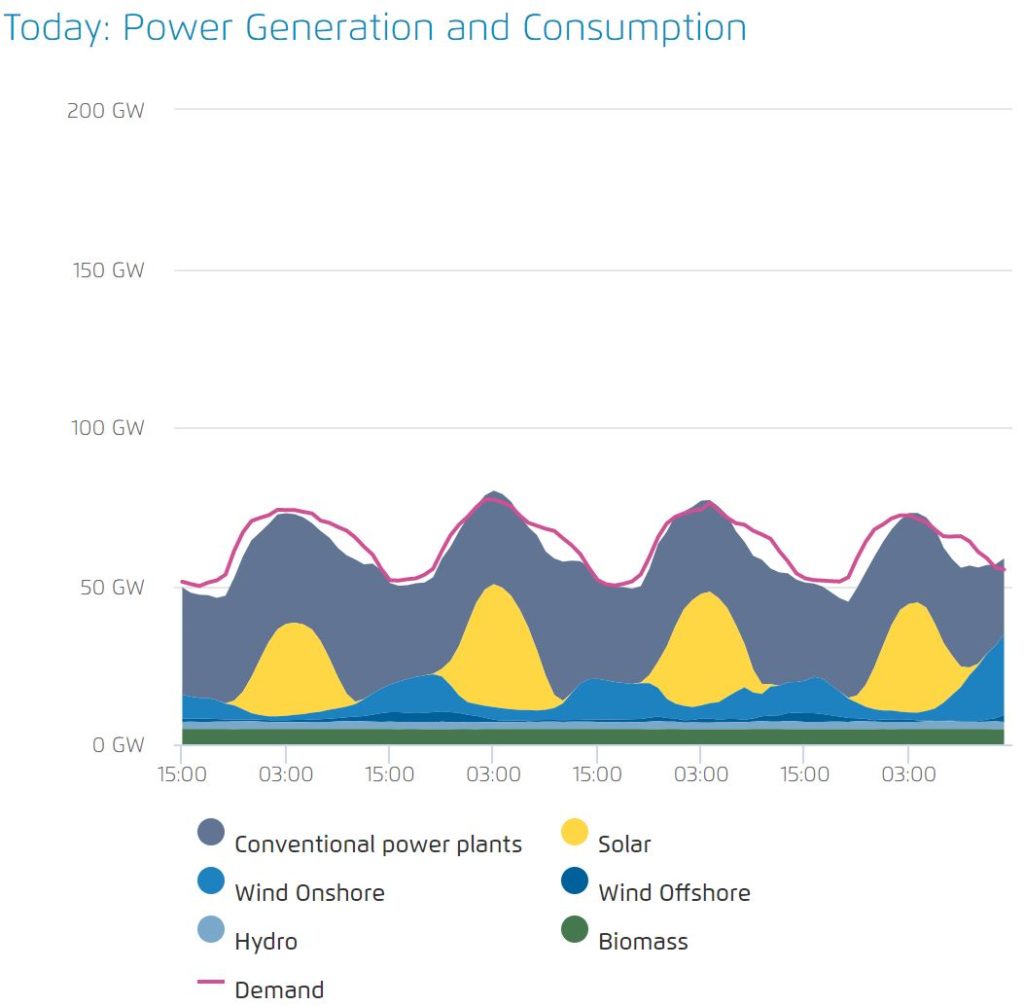
This picture will change dramatically going forward. A possible situation, based on targeted expansion of wind and solar for 2035 is shown below. Residual load refers to load to be served by imports, battery storage and conventional power generation. The total demand, as well as the amplitude between peak and valleys in generation and demand, will be much higher than in 2022.
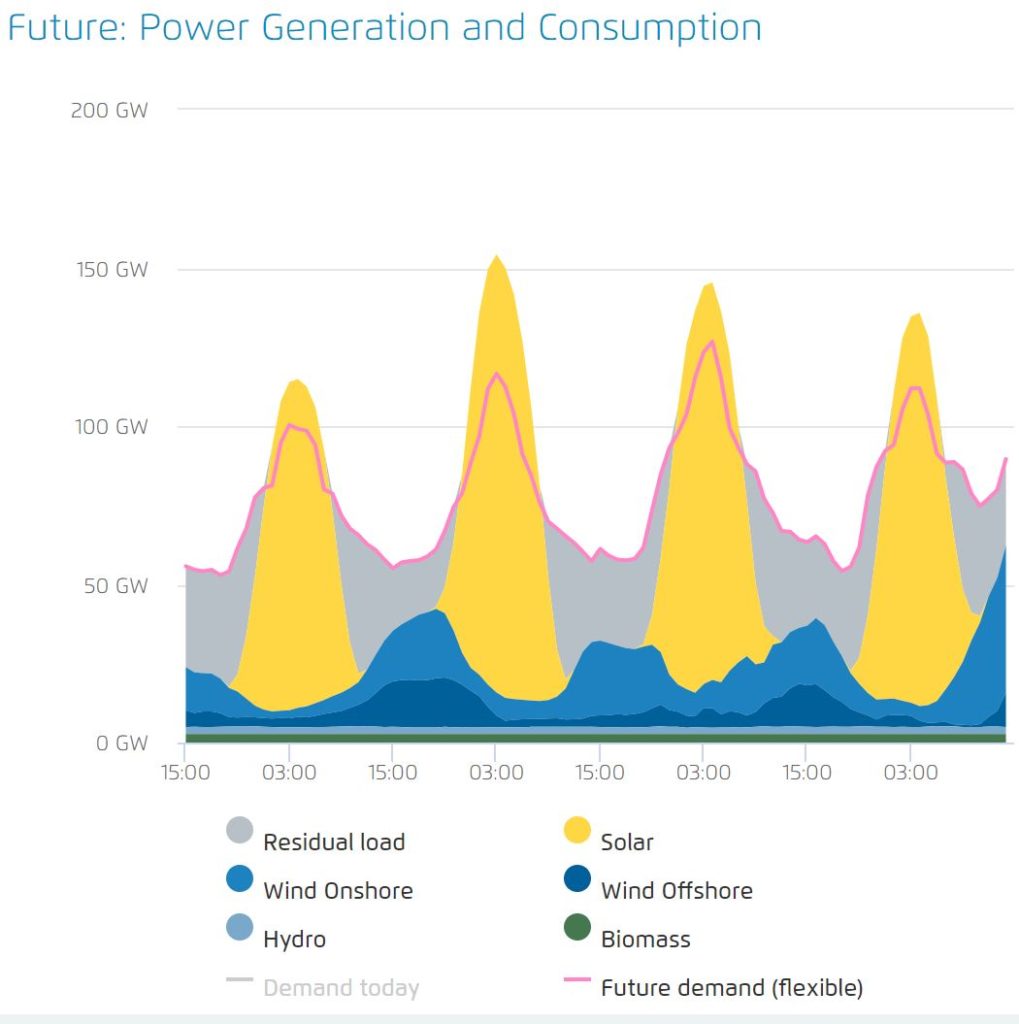
In the future German electric system, there will also be periods of vast amounts of excess power. To avoid curtailing generation during those periods, some of the excess power may be exported to neighboring countries and/or stored in batteries, but it will be far from enough to avoid curtailing. For proponents of green hydrogen, it represents an opportunity cost to produce green hydrogen. Thirty percent of the electric energy is lost in the electrolysis, compression, and transportation of the hydrogen. It makes it much less efficient and less economical than using the electricity directly or stored in batteries, but the equation changes when the electric power is “free”.
Recognizing the possibilities of hydrogen of bulk energy storage, and as a potential fuel source for flexible generation, as well as the need for green hydrogen to enable production of “green steel”, Germany developed early a National Hydrogen Strategy. As part of the strategy, it also seeks to make Germany becoming a leader and exporter of green hydrogen technologies. $8.1 billion has been allocated to speed up the commercialization of hydrogen technologies, and to achieve 5 GW electrolyzers capacity by 2030. This target is now expected to be raised to 10 GW. Some studies suggest over 80 GW by 2045 as part of the Energiewende.
The energy transition is not a done deal, far from it. As with most long-term plans and forecasts there are many challenges and uncertainties, ahead. Assumptions of legislative and financial support can change. Can all the wind and solar be built? Can all needed new transmission lines be built? Will neighboring countries have enough power to export to Germany? Will decarbonization of the transportation sector move forward as projected or will supply chain issues for batteries slow the growth. If that happens, will hydrogen be more interesting to store energy and power vehicles? Will there be new battery technologies? Will progress of carbon capture utilization and storage (CCUS) will make natural gas more attractive and utilized? Will small modular reactors bring a renaissance for nuclear power? Etc.
Germany is not unique in targeting net zero emissions by 2045. Many other countries have the same goal by 2045 or 2050, but are accepting large hydro, new nuclear and/or natural gas with CCUS as part of the portfolio of technologies to get them there at a lower cost, and maybe faster. What makes Germany unique is their approach to achieve the net-zero goal with such a high portion, close to 90% of variable renewable sources, wind and solar.
Triggered by the Russian invasion of Ukraine, Germany will accelerate its already aggressive energy transition. The massive expansion of wind and solar may also get green hydrogen to take off. If so, who would have guessed such unintended consequences of the invasion? Certainly not Russia.
From the very start of electricity, supply and demand had to be balanced.
Initially, it could be done by changing the output of the generators. The shifts in load were slow, mostly between day and night, and predictive.
This was the case through VWII, but after the war some fundamental changes, both load as well as of generation, made the balancing more demanding. On the load side the introduction of air conditioning significantly increased the amplitude between the bottom, referred to as the baseload, and the peak of demand. On the generation side nuclear power emerged. These plants had basically no flexibility and had to run all the time. Further, the increasingly large coal plants and the first generations of combined cycle gas turbines (CCGT) had limited flexibility. These generators, so called “baseload generators”, needed to be supplemented with more flexible generation to follow the load, from the baseload all the way to the peak power demand. Hydro power was the main flexible resource.
CONTINUE READING >>
Global warming is a global issue. Recognizing this fact, the international community, starting with the Earth Summit in Rio de Janeiro 1992, has tried to find a comprehensive global solution. Continuing through the Kyoto Protocol of 1997, the Paris Agreement in 2015 and the recently completed (2021) COP26 (the 26th UN Climate Change Conference) in Glasgow, there have been progress. However, the progress seems so far to be more of a deeper understanding of the problem and in setting ambitious targets than reaching a comprehensive solution with all nations committing to firm and specific actions to reduce emissions.
The problem not only remains but keeps growing. Carbon emissions continue to rise and accumulate in the atmosphere. Temperatures are inching up. Some countries have been successful reducing their emissions but taken together the greenhouse gas (GHG) emissions worldwide are increasing.
CONTINUE READING >>
Since 2019 wind has become the largest source of renewable energy in the US. In 2020 wind produced 8.4 % of all the electric energy. There is now more than 120 GW nameplate capacity of wind. Only 0.042 GW (42 MW) nameplate capacity is offshore wind. With an estimated cost at least twice as high as land-based wind and the costs of connecting to the onshore electric grid, at a first glance it would not seem that offshore wind could ever become of any significance.
However, at a closer look, there are strong reasons to believe offshore wind will become substantial with over 10 GW in operation already by 2030.
CONTINUE READING >>
The infamous “battle of currents” 1888-89 between Thomas Edison on one side and Nicolaus Tesla and George Westinghouse on the other side, was about the future of the electric system. Which was the superior technology, Direct Current (DC) or Alternating Current (AC)? AC won, and for over half a century it looked like an outcome with the winner takes all.
CONTINUE READING >>
Achieving “zero carbon emissions” (see footnote) without compromising safety and reliability, while keeping costs affordable, is not a trivial task. Countries that have succeeded or have come close are countries with a dominant portion of hydro power, for example Norway, Island, Costa Rica, Brazil, Canada. Also, countries like France and Sweden, with a mix of nuclear and hydro have achieved over ninety percent of zero emissions.
CONTINUE READING >>
The Global Energy Interconnection Development and Cooperation Organization (GEIDCO) was formed in March 2016. The purpose is to promote the sustainable development of energy worldwide. The vision of the Global Energy Interconnection (GEI) is “a clean energy dominant electric centric modern energy system that is globally interconnected, jointly constructed and mutually beneficial to all. It is an important platform for large scale development, transmission, and consumption of clean energy resources worldwide. In essence, GEI is Smart Grid + UHV (Ultra High Voltage) Grid +Clean Energy.”
CONTINUE READING >>